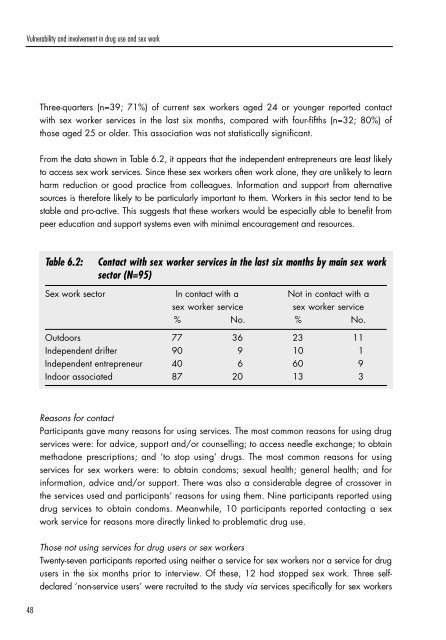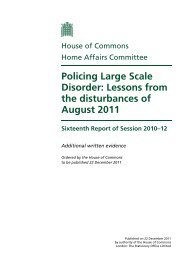Vulnerability and involvement in drug use and ... - Sex Work Europe
Vulnerability and involvement in drug use and ... - Sex Work Europe
Vulnerability and involvement in drug use and ... - Sex Work Europe
Create successful ePaper yourself
Turn your PDF publications into a flip-book with our unique Google optimized e-Paper software.
<strong>Vulnerability</strong> <strong>and</strong> <strong><strong>in</strong>volvement</strong> <strong>in</strong> <strong>drug</strong> <strong>use</strong> <strong>and</strong> sex work<br />
48<br />
Three-quarters (n=39; 71%) of current sex workers aged 24 or younger reported contact<br />
with sex worker services <strong>in</strong> the last six months, compared with four-fifths (n=32; 80%) of<br />
those aged 25 or older. This association was not statistically significant.<br />
F rom the data shown <strong>in</strong> Table 6.2, it appears that the <strong>in</strong>dependent entre p reneurs are least likely<br />
to access sex work services. S<strong>in</strong>ce these sex workers often work alone, they are unlikely to learn<br />
h a rm reduction or good practice from colleagues. Information <strong>and</strong> support from altern a t i v e<br />
s o u rces is there f o re likely to be particularly important to them. <strong>Work</strong>ers <strong>in</strong> this sector tend to be<br />
stable <strong>and</strong> pro-active. This suggests that these workers would be especially able to benefit fro m<br />
peer education <strong>and</strong> support systems even with m<strong>in</strong>imal encouragement <strong>and</strong> re s o u rc e s .<br />
Table 6.2: Contact with sex worker services <strong>in</strong> the last six months by ma<strong>in</strong> sex work<br />
sector (N=95)<br />
<strong>Sex</strong> work sector In contact with a Not <strong>in</strong> contact with a<br />
sex worker service sex worker service<br />
% No. % No.<br />
Outdoors 77 36 23 11<br />
Independent drifter 90 9 10 1<br />
Independent entrepreneur 40 6 60 9<br />
Indoor associated 87 20 13 3<br />
Reasons for contact<br />
Participants gave many reasons for us<strong>in</strong>g services. The most common reasons for us<strong>in</strong>g <strong>drug</strong><br />
services were: for advice, support <strong>and</strong>/or counsell<strong>in</strong>g; to access needle exchange; to obta<strong>in</strong><br />
methadone prescriptions; <strong>and</strong> ‘to stop us<strong>in</strong>g’ <strong>drug</strong>s. The most common reasons for us<strong>in</strong>g<br />
services for sex workers were: to obta<strong>in</strong> condoms; sexual health; general health; <strong>and</strong> for<br />
<strong>in</strong>formation, advice <strong>and</strong>/or support. There was also a considerable degree of crossover <strong>in</strong><br />
the services <strong>use</strong>d <strong>and</strong> participants’ reasons for us<strong>in</strong>g them. N<strong>in</strong>e participants reported us<strong>in</strong>g<br />
d rug services to obta<strong>in</strong> condoms. Meanwhile, 10 participants re p o rted contact<strong>in</strong>g a sex<br />
work service for reasons more directly l<strong>in</strong>ked to problematic <strong>drug</strong> <strong>use</strong>.<br />
Those not us<strong>in</strong>g services for <strong>drug</strong> <strong>use</strong>rs or sex workers<br />
Twenty-seven participants re p o rted us<strong>in</strong>g neither a service for sex workers nor a service for dru g<br />
<strong>use</strong>rs <strong>in</strong> the six months prior to <strong>in</strong>terv i e w. Of these, 12 had stopped sex work. Three self-<br />
d e c l a red ‘non-service <strong>use</strong>rs’ were re c ruited to the study v i a s e rvices specifically for sex workers
















